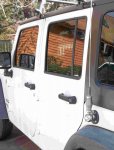I'm installing a 10 meter radio and Sirio 10 meter antenna in my 2012 Jeep Wrangler. I've run into an SWR issue and not sure how to deal with it. I'm using an MFJ- 259B antenna analyzer and can't get below 2.7 SWR at 50 ohms. The Jeep antenna mount is on the tailgate and doesn't have a decent ground so I installed a braided ground strap between the body and the tailgate. Something I find strange is that with the radio off I get 0 ohms through the ground wire from the radio to the vehicle chassis ground. When I turn the radio (Stryker ST 89MC 10 meter) on, the ohms reading on the ground is 0.16k to 0.20k ohms. The coax is new and check out ok.
Will someone please tell me what I'm doing wrong? I've got a suspicion the resistance on the ground wire is contributing to the SWR issue.
Any help will be appreciated.
KD5JNA
Will someone please tell me what I'm doing wrong? I've got a suspicion the resistance on the ground wire is contributing to the SWR issue.
Any help will be appreciated.
KD5JNA




